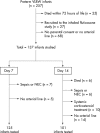Transient adrenocortical insufficiency of prematurity and systemic hypotension in very low birthweight infants
- PMID: 14977894
- PMCID: PMC1756043
- DOI: 10.1136/adc.2002.021972
Transient adrenocortical insufficiency of prematurity and systemic hypotension in very low birthweight infants
Abstract
Objectives: A proportion of preterm, very low birthweight (VLBW, < 1500 g) infants may show inadequate adrenal response to stress in the immediate postnatal period. The human corticotrophin releasing hormone (hCRH) stimulation test was used to: (a) determine the relation between pituitary-adrenal response and systemic blood pressure in these infants; (b) characterise the endocrinological features of transient adrenocortical insufficiency of prematurity (TAP).
Study design: A total of 226 hCRH tests were performed on 137 VLBW infants on day 7 and 14 of life in a tertiary neonatal centre.
Results: Basal, peak, and incremental rise in serum cortisol (Delta Cort(0-30)) on day 7 were associated significantly with the lowest systolic, mean, and diastolic blood pressures recorded during the first two weeks of life (r > 0.25, p < 0.005). These cortisol concentrations also correlated significantly but negatively with the maximum and total cumulative dose of dopamine (r > -0.22, p < 0.02), dobutamine (r > -0.18, p < 0.04), and adrenaline (r > -0.26, p < 0.004), total volume of crystalloid (r > -0.22, p < 0.02), and duration of inotrope treatment (r > -0.25, p < 0.006). Multivariate regression analysis of significant factors showed that the lowest systolic, mean, and diastolic blood pressures remained independently associated with serum cortisol (basal, peak, and Delta Cort(0-30)) on day 7. Hypotensive infants requiring inotropes (group 2) were significantly less mature and more sick than infants with normal blood pressure (group 1). The areas under the ACTH response curves were significantly greater in group 2 than in group 1, on both day 7 (p = 0.004) and day 14 (p = 0.004). In contrast, the area under the cortisol response curve was significantly greater in group 1 than in group 2 on day 7 (p = 0.001), but there was no significant difference between the two groups on day 14. In addition, serum cortisol at the 50th centile in hypotensive infants had high specificity and positive predictive value (0.80-0.93 and 0.81-0.89 respectively) for predicting early neonatal hypotension.
Conclusions: This study characterises the fundamental endocrinological features of TAP: normal or exaggerated pituitary response; adrenocortical insufficiency; good recovery of adrenal function by day 14 of postnatal life. The results also provide the centiles of serum cortisol for hypotensive patients and infants with normal blood pressure, and show a significant relation between serum cortisol and blood pressure in VLBW infants.
Figures



Similar articles
-
Reference ranges and factors affecting the human corticotropin-releasing hormone test in preterm, very low birth weight infants.J Clin Endocrinol Metab. 2002 Oct;87(10):4621-8. doi: 10.1210/jc.2001-011620. J Clin Endocrinol Metab. 2002. PMID: 12364445
-
Refractory hypotension in preterm infants with adrenocortical insufficiency.Arch Dis Child Fetal Neonatal Ed. 2001 Mar;84(2):F122-4. doi: 10.1136/fn.84.2.f122. Arch Dis Child Fetal Neonatal Ed. 2001. PMID: 11207229 Free PMC article.
-
Early pituitary-adrenal response and respiratory outcomes in preterm infants.Arch Dis Child Fetal Neonatal Ed. 2004 Mar;89(2):F127-30. doi: 10.1136/adc.2002.021980. Arch Dis Child Fetal Neonatal Ed. 2004. PMID: 14977895 Free PMC article.
-
[Adrenal function in very preterm infants in the early postnatal period].Klin Padiatr. 2001 Nov-Dec;213(6):307-13. doi: 10.1055/s-2001-18456. Klin Padiatr. 2001. PMID: 11713706 Review. German.
-
Relative adrenal insufficiency in the preterm and term infant.J Perinatol. 2009 May;29 Suppl 2:S44-9. doi: 10.1038/jp.2009.24. J Perinatol. 2009. PMID: 19399009 Review.
Cited by
-
Development and Validation of a Dynamic Nomogram to Predict the Risk of Neonatal White Matter Damage.Front Hum Neurosci. 2021 Feb 23;14:584236. doi: 10.3389/fnhum.2020.584236. eCollection 2020. Front Hum Neurosci. 2021. PMID: 33708079 Free PMC article.
-
Evidence for adverse effect of perinatal glucocorticoid use on the developing brain.Korean J Pediatr. 2014 Mar;57(3):101-9. doi: 10.3345/kjp.2014.57.3.101. Epub 2014 Mar 31. Korean J Pediatr. 2014. PMID: 24778691 Free PMC article. Review.
-
Low-frequency blood pressure oscillations and inotrope treatment failure in premature infants.J Appl Physiol (1985). 2017 Jul 1;123(1):55-61. doi: 10.1152/japplphysiol.00205.2017. Epub 2017 Apr 20. J Appl Physiol (1985). 2017. PMID: 28428252 Free PMC article.
-
Glucocorticoids, antenatal corticosteroid therapy and fetal heart maturation.J Mol Endocrinol. 2018 Jul;61(1):R61-R73. doi: 10.1530/JME-18-0077. Epub 2018 May 2. J Mol Endocrinol. 2018. PMID: 29720513 Free PMC article. Review.
-
Challenges in understanding the impact of blood pressure management on cerebral oxygenation in the preterm brain.Front Physiol. 2012 Dec 18;3:471. doi: 10.3389/fphys.2012.00471. eCollection 2012. Front Physiol. 2012. PMID: 23264765 Free PMC article.
References
MeSH terms
Substances
LinkOut - more resources
Full Text Sources
Medical
Miscellaneous
